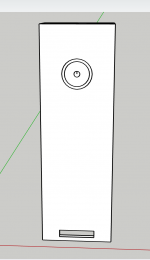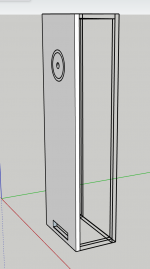Hello hello,
This is my first post here after spending a few late nights on the forums and imagining my first speaker build. Apologies in advance for any errors of diyAudio etiquette. Let me know if I should be moving this thread to another forum!
I'm an audio/music fan (but far from an expert or audiophile), and I'm planning a speaker build with my brother who is an artist and furniture designer. We'd like to make a (hopefully) simple pair of single-driver/full-range loudspeakers. We'd like them to sound good, with a decent frequency response, but we don't need them to sound exceptional. Better than a little Sonos unit, I'd hope, but no need to compete with £5000 audiophile speakers. HOWEVER, we'd like to get quite creative with the aesthetic design. And I'm struggling to find much info on how specific aesthetically-motivated changes will affect sound, so I thought I'd stick my neck out and ask the diyAudio experts!
I have loads to read and learn, especially if not following a pre-existing build plan. But before we go further, I have two big questions which will affect our approach:
1. What are the important considerations when fixing additional material to the outside of a speaker cabinet? For example, could we build a tried and tested speaker, and then glue/screw another empty box on top of it in order to change the physical proportions for aesthetic reasons? Another example: could we glue/screw little details onto the side, top, or bottom of a cabinet, such as a small carved wooden sculpture?
2. Are there any limitations to veneer materials, assuming an mdf enclosure? In particular, we are interested in using a thin aluminium veneer, as well as burr walnut and white melamine (not all together!). It would be great to know if there are any 'no-go' materials for veneers?
For what it's worth, my current plan is to use the Mark Audio Alpair 10p, which seems to be well-regarded. Depending on answers to the above, I'm imagining we'll use one of the build plans on the Mark Audio website (e.g. https://www.markaudio.com/wp-content/uploads/2022/08/Despina-Alpair-10.3-10P-RTL.png OR http://wodendesign.com/downloads/simpleReflex-103-10p-plan-100214.pdf), at least to give us a basic structure. As a bonus question, I'm wondering to what extent we could change the positioning of the driver and port holes on tried and tested transmission line and vented designs, as long as the volumes and circumferences remained the same? E.g. putting the driver in the middle of the box rather than towards the top.
Thanks in advance for your patience, and for any help you're able to offer!
Lewis
This is my first post here after spending a few late nights on the forums and imagining my first speaker build. Apologies in advance for any errors of diyAudio etiquette. Let me know if I should be moving this thread to another forum!
I'm an audio/music fan (but far from an expert or audiophile), and I'm planning a speaker build with my brother who is an artist and furniture designer. We'd like to make a (hopefully) simple pair of single-driver/full-range loudspeakers. We'd like them to sound good, with a decent frequency response, but we don't need them to sound exceptional. Better than a little Sonos unit, I'd hope, but no need to compete with £5000 audiophile speakers. HOWEVER, we'd like to get quite creative with the aesthetic design. And I'm struggling to find much info on how specific aesthetically-motivated changes will affect sound, so I thought I'd stick my neck out and ask the diyAudio experts!
I have loads to read and learn, especially if not following a pre-existing build plan. But before we go further, I have two big questions which will affect our approach:
1. What are the important considerations when fixing additional material to the outside of a speaker cabinet? For example, could we build a tried and tested speaker, and then glue/screw another empty box on top of it in order to change the physical proportions for aesthetic reasons? Another example: could we glue/screw little details onto the side, top, or bottom of a cabinet, such as a small carved wooden sculpture?
2. Are there any limitations to veneer materials, assuming an mdf enclosure? In particular, we are interested in using a thin aluminium veneer, as well as burr walnut and white melamine (not all together!). It would be great to know if there are any 'no-go' materials for veneers?
For what it's worth, my current plan is to use the Mark Audio Alpair 10p, which seems to be well-regarded. Depending on answers to the above, I'm imagining we'll use one of the build plans on the Mark Audio website (e.g. https://www.markaudio.com/wp-content/uploads/2022/08/Despina-Alpair-10.3-10P-RTL.png OR http://wodendesign.com/downloads/simpleReflex-103-10p-plan-100214.pdf), at least to give us a basic structure. As a bonus question, I'm wondering to what extent we could change the positioning of the driver and port holes on tried and tested transmission line and vented designs, as long as the volumes and circumferences remained the same? E.g. putting the driver in the middle of the box rather than towards the top.
Thanks in advance for your patience, and for any help you're able to offer!
Lewis
1. Minor changes is OK drastically changing the baffle (ths side of the box with the drivers will affect the frequency response/tonalaty. Especially changing the with of the baffle, height is less critical. Ornamenst on side top bottom is OK as well, not on the front baffle especially around the tweeter.
2. There are no nogo veneer material
You can mont the driver on the side or back side of the Despina or the SimpleReflex, it will not destroy the function of the speaker. It will alter the function, by how much I have no idea. But for a noncritical application why not.
Why not build testboxes of cheap chipbord or OSB. If they sound OK, build the real thing with all the elaborate trimmings!
2. There are no nogo veneer material
You can mont the driver on the side or back side of the Despina or the SimpleReflex, it will not destroy the function of the speaker. It will alter the function, by how much I have no idea. But for a noncritical application why not.
Why not build testboxes of cheap chipbord or OSB. If they sound OK, build the real thing with all the elaborate trimmings!
I'm liking the pensil designs for it.
I've not heard the driver though.
I've not heard the driver though.
Last edited by a moderator:
Hi @DrBoar and @norman bates
Thanks so much for responding! That’s all really helpful info. I was briefly looking into baffle step diffraction/compensation yesterday, so what you’ve said about changing the baffle (especially width) is adding up in my mind now. The point about width has got me thinking: does that mean that turning a tried and tested speaker design (e.g. Despina, Pensil, or Simple Reflex) on its side could significantly affect the sound? That seems counterintuitive to me, but I guess it would mean dramatically increasing the width of the baffle and therefore changing the diffraction stuff?
And thanks for your comment about the position of the driver. I was actually thinking more about the relative height of the driver. E.g. moving the driver lower down the baffle, rather than putting it on the side or back side. Would your answer still apply? I.e. it would have an effect but probably not a particularly noticeable effect in non-critical settings?
Yes, I think building a couple of test boxes from cheap materials sounds like a smart idea 🙂
Thanks so much for responding! That’s all really helpful info. I was briefly looking into baffle step diffraction/compensation yesterday, so what you’ve said about changing the baffle (especially width) is adding up in my mind now. The point about width has got me thinking: does that mean that turning a tried and tested speaker design (e.g. Despina, Pensil, or Simple Reflex) on its side could significantly affect the sound? That seems counterintuitive to me, but I guess it would mean dramatically increasing the width of the baffle and therefore changing the diffraction stuff?
And thanks for your comment about the position of the driver. I was actually thinking more about the relative height of the driver. E.g. moving the driver lower down the baffle, rather than putting it on the side or back side. Would your answer still apply? I.e. it would have an effect but probably not a particularly noticeable effect in non-critical settings?
Yes, I think building a couple of test boxes from cheap materials sounds like a smart idea 🙂
but no need to compete with £5000 audiophile speakers
It would take about £300 and a decent project to get close to that. No consideration for cosmetics.
1. What are the important considerations when fixing additional material to the outside of a speaker cabinet? For example, could we build a tried and tested speaker, and then glue/screw another empty box on top of it in order to change the physical proportions for aesthetic reasons? Another example: could we glue/screw little details onto the side, top, or bottom of a cabinet, such as a small carved wooden sculpture?
aking the enclosure thicker and less unifornm will usually decrease resonance potential, but i have had at least 2 instances where adding "thick veneer” made things worse and more bracing was required. Little bits added can be used as external bracing and box shaping for lower defraction signature.
These worked worse after the "thick veneer”


Bracing.shaping.
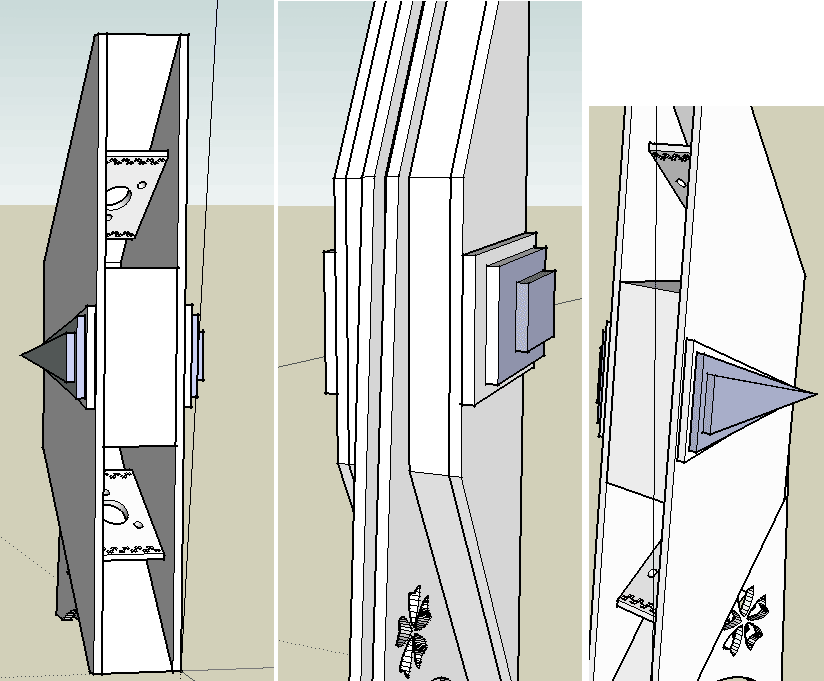
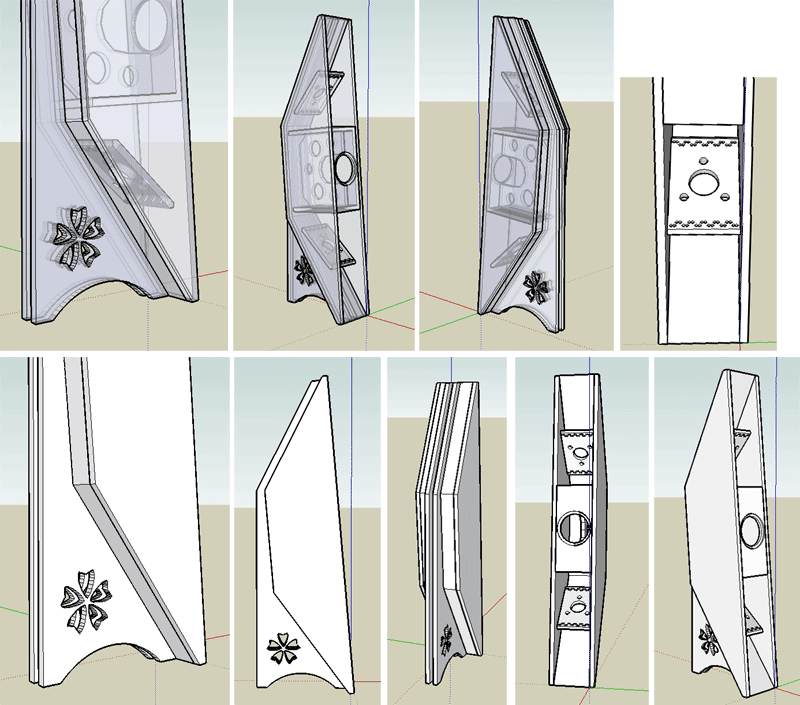
When adding external embelishments think about how they will affext diffraction
2. Are there any limitations to veneer materials, assuming an mdf enclosure? In particular, we are interested in using a thin aluminium veneer, as well as burr walnut and white melamine (not all together!). It would be great to know if there are any 'no-go' materials for veneers?
MDF is a poor starting point, find some quality plywood. Adding something like an Al skin, if used with the right glue should inprove performance. It should also be done inside from a structural point of view and like the first 2 pictures not end up going the wrong way.
The key here is that these materials (ie thin) increase the number of plies in the plywood you are using, increasing stiffness (at least in theory)
my current plan is to use the Mark Audio Alpair 10p
Definitly possible t get competitive with £5k high street shop with that driver, Do notr that the A10p has a particular sound signiture (i call vintage) with a soft end and “romantic” midrange that puts some to want to add a tweeter or push the EQ and others to just fall in love. Particularily good with SETs.
Despina another one to do aproper drawing of… simpleReflex, properly dran up. The first gives a better chance to adjust damoping to room and taste, and would be y personal pick (except that ego would push me more towards here:
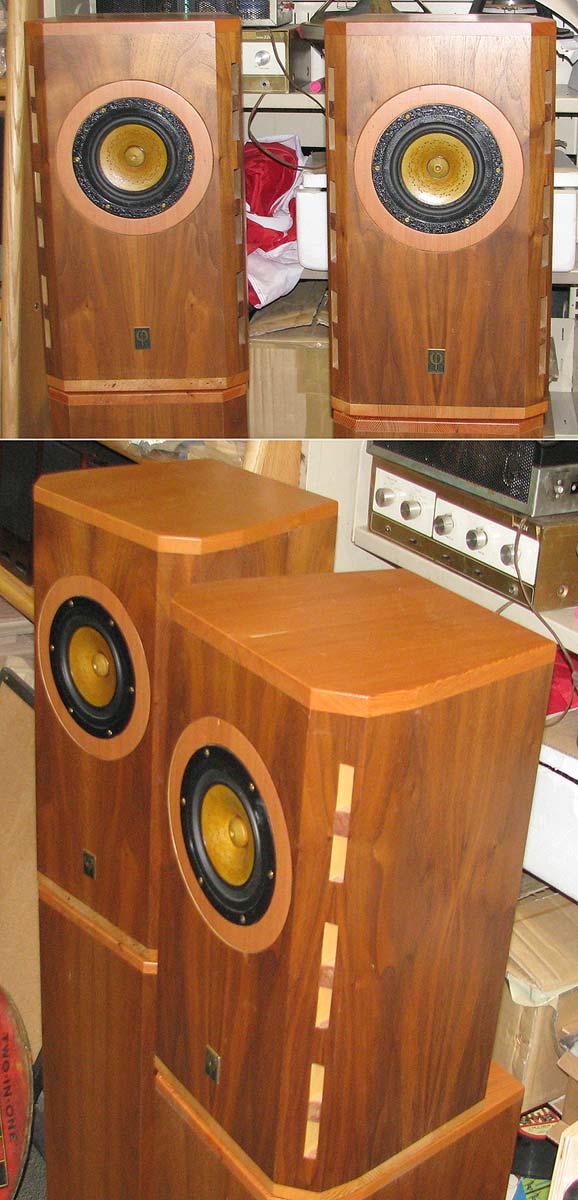
I'm wondering to what extent we could change the positioning of the driver and port holes on tried and tested transmission line and vented designs
Few options in the TL, much more freedom with the vented box.
Pick a box that is cloed to the end point you want, between Scott & i we could probably scare up over 20 different boxes, do you have sketches of where you’d like to go.
dave
The plywood might sound better but it does not measure better than MDF. The two german DIY audio magazines Hobby HiFI and Klang & Ton have made measurements both of sound transmission and panel vibrations. Constrained layers seems to be the best as far as measurement goes!
How measurements and sound qulity correlate is an other kettle of fish.
How measurements and sound qulity correlate is an other kettle of fish.
Thank you both @planet10 and @DrBoar. Very helpful stuff. Few things to add on my part, I think!
I've actually been thinking of changing driver to the CHP-70. I saw some comments suggesting that the A10p would almost be too good. People say it exposes sub-standard gear in the chain/source material. I'd love to upgrade my amp at some point, but I'm not keen to spend hundreds and hundreds or to commit to building something. It's currently a cheap vintage integrated unit, and my chain also includes a DJ mixer, un-serviced 1210 turntables, a £20 bluetooth receiver, and a cheap tape deck. I listen to music through spotify and dirty/badly pressed vinyl half the time. So there's a lot of crap to expose! And not enough money to clean the whole chain up in the foreseeable future. From what I can tell, the CHP-70 is a bit more suitable for the generalist rather than the audiophile? And it's cheaper, iirc.
Anyway, back to the cabinets.
I've actually been thinking of changing driver to the CHP-70. I saw some comments suggesting that the A10p would almost be too good. People say it exposes sub-standard gear in the chain/source material. I'd love to upgrade my amp at some point, but I'm not keen to spend hundreds and hundreds or to commit to building something. It's currently a cheap vintage integrated unit, and my chain also includes a DJ mixer, un-serviced 1210 turntables, a £20 bluetooth receiver, and a cheap tape deck. I listen to music through spotify and dirty/badly pressed vinyl half the time. So there's a lot of crap to expose! And not enough money to clean the whole chain up in the foreseeable future. From what I can tell, the CHP-70 is a bit more suitable for the generalist rather than the audiophile? And it's cheaper, iirc.
Anyway, back to the cabinets.
Great to know – thank you. It sounds as if sticking to thin veneer is best. And we should test (especially if using thick veneer) before and after adding veneer in case it makes sound worse, keeping in mind that bracing might correct for any worsening sound.aking the enclosure thicker and less unifornm will usually decrease resonance potential, but i have had at least 2 instances where adding "thick veneer” made things worse and more bracing was required. Little bits added can be used as external bracing and box shaping for lower defraction signature.
Is Al aluminium? If so, great that it could improve performance, but I'm surprised to learn it should go on the inside too. I thought the idea was to deaden the inside with foamy stuff, rather than adding something reflective like aluminium?Adding something like an Al skin, if used with the right glue should inprove performance. It should also be done inside from a structural point of view and like the first 2 pictures not end up going the wrong way.
Apologies, not familiar with this abbreviation?SETs
Those are some beautiful designs you posted. Thanks again. Having changed tack to the CHP 70 and had a further look at cabinet plans, I'm now drawn to the pensil, although we are interested in different options for proportions. Personally, I prefer wide and shallow rather than deep and narrow, so would be curious to hear about alternatives to the pensil. Floorstanding is probably the prefered root, but I do like the look of the golden ratio designs a lot, so might consider building some interesting stands. Do you have any suggestions?Few options in the TL, much more freedom with the vented box.
Pick a box that is cloed to the end point you want, between Scott & i we could probably scare up over 20 different boxes, do you have sketches of where you’d like to go.
While the last bit can certainly be true, note that the CHP-70.2 has a top end mant to be vintage but they only managed to have a driver down 10 dB above 5kHz, with a significant rise just before the plunge. Most people miss the top, but those that do not love the driver. They do not have the same bass potential as A10p. It fits in smaller boxes.I've actually been thinking of changing driver to the CHP-70. I saw some comments suggesting that the A10p would almost be too good. People say it exposes sub-standard gear in the chain/source material.
Coincidentally i have 1 pair left CHP-70.2eN that both does the no top end trick and the reveal if what proceedsis not great trick .
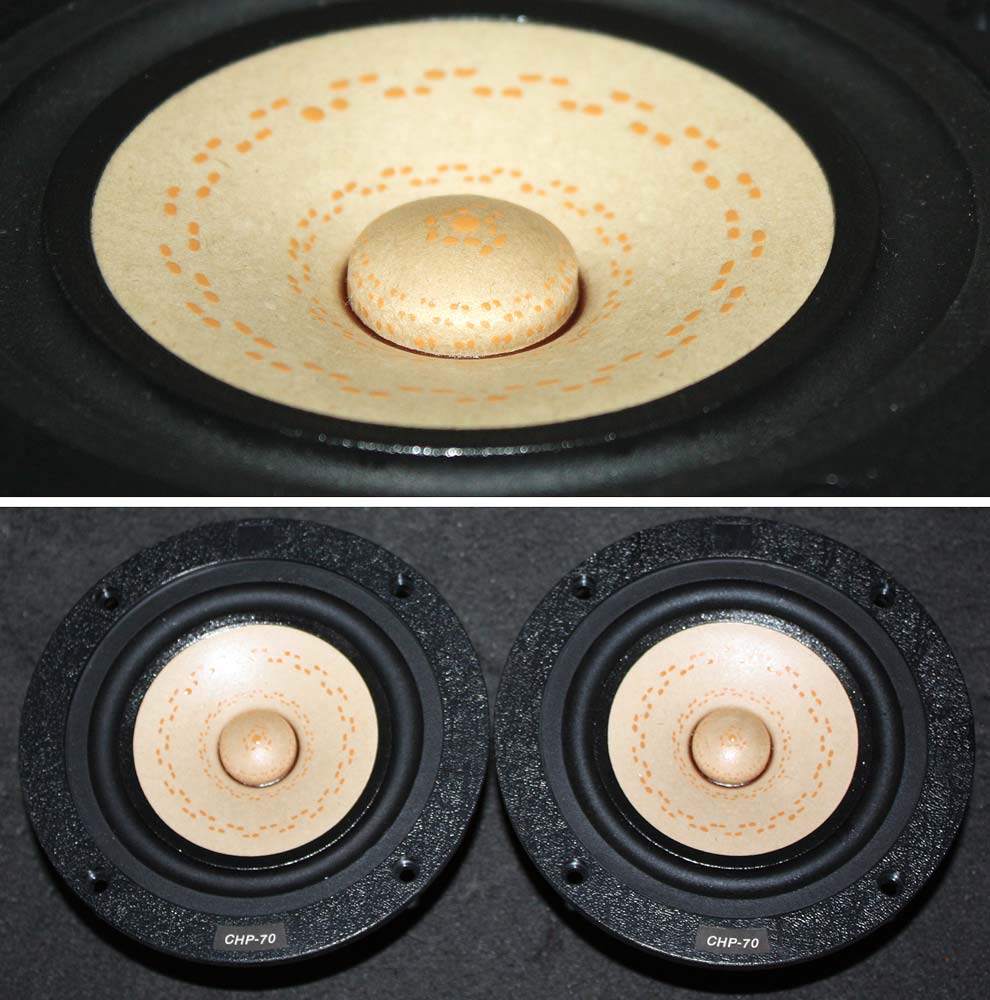
dave
The two german DIY audio magazines...
I have seen all those and more, i will not use MDF.
dave
Thanks again Dave. Really appreciate your insights! I'd read about the CHP-70's 'vintage' tone. It doesn't sound all that bad to me (less fatiguing, maybe?). And I can't help but wonder how noticeable the high-end drop would be for someone like me. Given I'm not used to listening to audiophile-grade speakers, and don't have others to compare the CHP-70 to, I'd inclined to think I'll still be impressed with the sound?
Without wanting to push my luck, I wonder if you have any suggestions for floorstanidng cabinet designs. Is it the Pensil all the way with these drivers? And is there any scope to modify the pensil without dramatically worsening performance, e.g. to make it wider and shallower?
Thanks,
Lewis
Without wanting to push my luck, I wonder if you have any suggestions for floorstanidng cabinet designs. Is it the Pensil all the way with these drivers? And is there any scope to modify the pensil without dramatically worsening performance, e.g. to make it wider and shallower?
Thanks,
Lewis
Last edited by a moderator:
(less fatiguing, maybe?)
As long as the bit of bighr just before the cliff hits a nerve. But that can fairly easily be partially smoothed. Its about a 6 dB bump before a plunge, it is the abrupt change that can be disconcerting. The article i pinched that from (attached) is quite insightful. The CHBW-70 is 5dB steeper.very simila but that pluhge is about. The blue bit is his measurement with a passive added to it.
dave
Attachments
I'll still be impressed with the sound
It has a very good midrange, and the potential for decent bass.
As long as thre cross-section, Zd (distance driver is from the top), height, and the terminus areaand length (18-20mm) you should be fine.
I just shipped out a pair of CHBW loaded Thirlmere-R (Lake District <https://p10hifi.net/FH/downloads/Lake-District-maps-080909.pdf>). We changed the driver mounting, this is a floor standing BVR (BigVentReflex). It could be halved for a single drive ror use 2/per and take advantage of greater bass omph (I’m gonna guess that 4 x CHP7- is about the same as 2 x A10p price wise). A;; the other Lake District should work as well.
dave
Hi @planet10 , thanks again!
On the basis of your last message, I just had a play around. Figured the pensil turned sideways – with the driver and the outlet on what was the side face rather than the front – might give some nice proportions. I know increasing the baffle width will mean diffraction of a wider frequency range, but I'm thinking that might be compensated for by the already diminished highs on the driver?
I mocked it up in sketchup. Would be great to hear what you think?
On the basis of your last message, I just had a play around. Figured the pensil turned sideways – with the driver and the outlet on what was the side face rather than the front – might give some nice proportions. I know increasing the baffle width will mean diffraction of a wider frequency range, but I'm thinking that might be compensated for by the already diminished highs on the driver?
I mocked it up in sketchup. Would be great to hear what you think?
Attachments
I know increasing the baffle width will mean diffraction of a wider frequency range
Given the HF dispersion of the driver, not an issue.
dave
Last edited:
- Home
- Loudspeakers
- Full Range
- Adding material to full-range cabinet?
